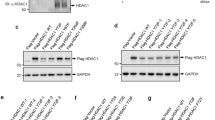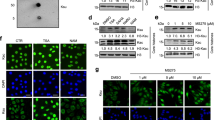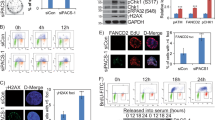Abstract
Histone deacetylase 6 (HDAC6) is a unique enzyme with specific structural and functional features. It is actively or stably maintained in the cytoplasm and is the only member, within the histone deacetylase family, that harbors a full duplication of its deacetylase homology region followed by a specific ubiquitin-binding domain at the C-terminus end. Accordingly, this deacetylase functions at the heart of a cellular regulatory mechanism capable of coordinating various cellular functions largely relying on the microtubule network. Moreover, HDAC6 action as a regulator of the HSP90 chaperone activity adds to the multifunctionality of the protein, and allows us to propose a critical role for HDAC6 in mediating and coordinating various cellular events in response to different stressful stimuli.
This is a preview of subscription content, access via your institution
Access options
Subscribe to this journal
Receive 50 print issues and online access
$259.00 per year
only $5.18 per issue
Buy this article
- Purchase on Springer Link
- Instant access to full article PDF
Prices may be subject to local taxes which are calculated during checkout


Similar content being viewed by others
References
Adachi N, Kimura A, Horikoshi M . (2002). A conserved motif common to the histone acetyltransferase Esa1 and the histone deacetylase Rpd3. J Biol Chem 277: 35688–35695.
Amann JM, Nip J, Strom DK, Lutterbach B, Harada H, Lenny N et al. (2001). ETO, a target of t(8;21) in acute leukemia, makes distinct contacts with multiple histone deacetylases and binds mSin3A through its oligomerization domain. Mol Cell Biol 21: 6470–6483.
Amerik AY, Li SJ, Hochstrasser M . (2000). Analysis of the deubiquitinating enzymes of the yeast Saccharomyces cerevisiae. Biol Chem 381: 981–992.
Bali P, Pranpat M, Bradner J, Balasis M, Fiskus W, Guo F et al. (2005). Inhibition of histone deacetylase 6 acetylates and disrupts the chaperone function of heat shock protein 90: a novel basis for antileukemia activity of histone deacetylase inhibitors. J Biol Chem 280: 26729–26734.
Barlow AL, van Drunen CM, Johnson CA, Tweedie S, Bird A, Turner BM . (2001). dSIR2 and dHDAC6: two novel, inhibitor-resistant deacetylases in Drosophila melanogaster. Exp Cell Res 265: 90–103.
Bershadsky AD, Ballestrem C, Carramusa L, Zilberman Y, Gilquin B, Khochbin S et al. (2006). Assembly and mechanosensory function of focal adhesions: experiments and models. Eur J Cell Biol 85: 165–173.
Bertos NR, Gilquin B, Chan GK, Yen TJ, Khochbin S, Yang XJ . (2004). Role of the tetradecapeptide repeat domain of human histone deacetylase 6 in cytoplasmic retention. J Biol Chem 279: 48246–48254.
Blagosklonny MV . (2002). Hsp-90-associated oncoproteins: multiple targets of geldanamycin and its analogs. Leukemia 16: 455–462.
Boyault C, Gilquin B, Zhang Y, Rybin V, Garman E, Meyer-Klaucke W et al. (2006). HDAC6-p97/VCP controlled polyubiquitin chain turnover. EMBO J 25: 3357–3366.
Bradbury CA, Khanim FL, Hayden R, Bunce CM, White DA, Drayson MT et al. (2005). Histone deacetylases in acute myeloid leukaemia show a distinctive pattern of expression that changes selectively in response to deacetylase inhibitors. Leukemia 19: 1751–1759.
Brush MH, Guardiola A, Connor JH, Yao TP, Shenolikar S . (2004). Deactylase inhibitors disrupt cellular complexes containing protein phosphatases and deacetylases. J Biol Chem 279: 7685–7691.
Cabrero JR, Serrador JM, Barreiro O, Mittelbrunn M, Naranjo-Suarez S, Martin-Cofreces N et al. (2006). Lymphocyte chemotaxis is regulated by histone deacetylase 6, independently of its deacetylase activity. Mol Biol Cell 17: 3435–3445.
Caron C, Boyault C, Khochbin S . (2005). Regulatory cross-talk between lysine acetylation and ubiquitination: role in the control of protein stability. Bioessays 27: 408–415.
Caron C, Col E, Khochbin S . (2003). The viral control of cellular acetylation signaling. Bioessays 25: 58–65.
Carta S, Tassi S, Semino C, Fossati G, Mascagni P, Dinarello CA et al. (2006). Histone deacetylase inhibitors prevent exocytosis of interleukin-1beta-containing secretory lysosomes: role of microtubules. Blood 108: 1618–1626.
Cohen HY, Lavu S, Bitterman KJ, Hekking B, Imahiyerobo TA, Miller C et al. (2004). Acetylation of the C terminus of Ku70 by CBP and PCAF controls Bax-mediated apoptosis. Mol Cell 13: 627–638.
Corcoran LJ, Mitchison TJ, Liu Q . (2004). A novel action of histone deacetylase inhibitors in a protein aggresome disease model. Curr Biol 14: 488–492.
Destaing O, Saltel F, Gilquin B, Chabadel A, Khochbin S, Ory S et al. (2005). A novel Rho-mDia2-HDAC6 pathway controls podosome patterning through microtubule acetylation in osteoclasts. J Cell Sci 118: 2901–2911.
Dihazi H, Kessler R, Muller GA, Eschrich K . (2005). Lysine 3 acetylation regulates the phosphorylation of yeast 6-phosphofructo-2-kinase under hypo-osmotic stress. Biol Chem 386: 895–900.
Fernandes I, Bastien Y, Wai T, Nygard K, Lin R, Cormier O et al. (2003). Ligand-dependent nuclear receptor corepressor LCoR functions by histone deacetylase-dependent and -independent mechanisms. Mol Cell 11: 139–150.
Fischer DD, Cai R, Bhatia U, Asselbergs FA, Song C, Terry R et al. (2002). Isolation and characterization of a novel class II histone deacetylase, HDAC10. J Biol Chem 277: 6656–6666.
Furumai R, Matsuyama A, Kobashi N, Lee KH, Nishiyama M, Nakajima H et al. (2002). FK228 (depsipeptide) as a natural prodrug that inhibits class I histone deacetylases. Cancer Res 62: 4916–4921.
Gao L, Cueto MA, Asselbergs F, Atadja P . (2002). Cloning and functional characterization of HDAC11, a novel member of the human histone deacetylase family. J Biol Chem 277: 25748–25755.
Girdwood D, Bumpass D, Vaughan OA, Thain A, Anderson LA, Snowden AW et al. (2003). P300 transcriptional repression is mediated by SUMO modification. Mol Cell 11: 1043–1054.
Glozak MA, Sengupta N, Zhang X, Seto E . (2005). Acetylation and deacetylation of non-histone proteins. Gene 363: 15–23.
Goldberg AL, Cascio P, Saric T, Rock KL . (2002). The importance of the proteasome and subsequent proteolytic steps in the generation of antigenic peptides. Mol Immunol 39: 147–164.
Grozinger CM, Hassig CA, Schreiber SL . (1999). Three proteins define a class of human histone deacetylases related to yeast Hda1p. Proc Natl Acad Sci USA 96: 4868–4873.
Guardiola AR, Yao TP . (2002). Molecular cloning and characterization of a novel histone deacetylase HDAC10. J Biol Chem 277: 3350–3356.
Gurvich N, Tsygankova OM, Meinkoth JL, Klein PS . (2004). Histone deacetylase is a target of valproic acid-mediated cellular differentiation. Cancer Res 64: 1079–1086.
Haggarty SJ, Koeller KM, Wong JC, Grozinger CM, Schreiber SL . (2003). Domain-selective small-molecule inhibitor of histone deacetylase 6 (HDAC6)-mediated tubulin deacetylation. Proc Natl Acad Sci USA 100: 4389–4394.
Hallows WC, Lee S, Denu JM . (2006). Sirtuins deacetylate and activate mammalian acetyl-CoA synthetases. Proc Natl Acad Sci USA 103: 10230–10235.
Hayashi S, Yamaguchi Y . (2006). Basic research for hormone-sensitivity of breast cancer. Breast Cancer 13: 123–128.
Hideshima T, Bradner JE, Wong J, Chauhan D, Richardson P, Schreiber SL et al. (2005). Small-molecule inhibition of proteasome and aggresome function induces synergistic antitumor activity in multiple myeloma. Proc Natl Acad Sci USA 102: 8567–8872.
Hook SS, Orian A, Cowley SM, Eisenman RN . (2002). Histone deacetylase 6 binds polyubiquitin through its zinc finger (PAZ domain) and copurifies with deubiquitinating enzymes. Proc Natl Acad Sci USA 99: 13425–13430.
Hubbert C, Guardiola A, Shao R, Kawaguchi Y, Ito A, Nixon A et al. (2002). HDAC6 is a microtubule-associated deacetylase. Nature 417: 455–458.
Hurst DR, Mehta A, Moore BP, Phadke PA, Meehan WJ, Accavitti MA et al. (2006). Breast cancer metastasis suppressor 1 (BRMS1) is stabilized by the Hsp90 chaperone. Biochem Biophys Res Commun 348: 1429–1435.
Iwabata H, Yoshida M, Komatsu Y . (2005). Proteomic analysis of organ-specific post-translational lysine-acetylation and -methylation in mice by use of anti-acetyllysine and -methyllysine mouse monoclonal antibodies. Proteomics 18: 4653–4664.
Iwata A, Riley BE, Johnston JA, Kopito RR . (2005). HDAC6 and microtubules are required for autophagic degradation of aggregated huntingtin. J Biol Chem 280: 40282–40292.
Kao HY, Lee CH, Komarov A, Han CC, Evans RM . (2002). Isolation and characterization of mammalian HDAC10, a novel histone deacetylase. J Biol Chem 277: 187–193.
Kawaguchi Y, Kovacs JJ, McLaurin A, Vance JM, Ito A, Yao TP . (2003). The deacetylase HDAC6 regulates aggresome formation and cell viability in response to misfolded protein stress. Cell 115: 727–738.
Kim SC, Sprung R, Chen Y, Xu Y, Ball H, Pei J et al. (2006). Substrate and functional diversity of lysine acetylation revealed by a proteomics survey. Mol Cell 23: 607–618.
Kong X, Lin Z, Liang D, Fath D, Sang N, Caro J . (2006). Histone deacetylase inhibitors induce VHL and ubiquitin-independent proteasomal degradation of hypoxia-inducible factor 1alpha. Mol Cell Biol 26: 2019–2028.
Kouzarides T . (2000). Acetylation: a regulatory modification to rival phosphorylation? EMBO J 19: 1176–1179.
Kovacs JJ, Murphy PJ, Gaillard S, Zhao X, Wu JT, Nicchitta CV et al. (2005). HDAC6 regulates Hsp90 acetylation and chaperone-dependent activation of glucocorticoid receptor. Mol Cell 18: 601–607.
Ling L, Lobie PE . (2004). RhoA/ROCK activation by growth hormone abrogates p300/histone deacetylase 6 repression of Stat5-mediated transcription. J Biol Chem 279: 32737–32750.
Ma H, Nguyen C, Lee KS, Kahn M . (2005). Differential roles for the coactivators CBP and p300 on TCF/beta-catenin-mediated survivin gene expression. Oncogene 24: 3619–3631.
Marcus AI, O’Brate A M, Buey RM, Zhou J, Thomas S, Khuri FR et al. (2006). Farnesyltransferase inhibitors reverse taxane resistance. Cancer Res 66: 8838–8846.
Marcus AI, Zhou J, O’Brate A, Hamel E, Wong J, Nivens M et al. (2005). The synergistic combination of the farnesyl transferase inhibitor lonafarnib and paclitaxel enhances tubulin acetylation and requires a functional tubulin deacetylase. Cancer Res 65: 3883–3893.
Matsuyama A, Shimazu T, Sumida Y, Saito A, Yoshimatsu Y, Seigneurin-Berny D et al. (2002). In vivo destabilization of dynamic microtubules by HDAC6-mediated deacetylation. EMBO J 21: 6820–6831.
Mosley AJ, Meekings KN, McCarthy C, Shepherd D, Cerundolo V, Mazitschek R et al. (2006). Histone deacetylase inhibitors increase virus gene expression but decrease CD8+ cell antiviral function in HTLV-1 infection. Blood 108: 3801–3807.
Murphy PJ, Morishima Y, Kovacs JJ, Yao TP, Pratt WB . (2005). Regulation of the dynamics of hsp90 action on the glucocorticoid receptor by acetylation/deacetylation of the chaperone. J Biol Chem 280: 33792–33799.
North BJ, Marshall BL, Borra MT, Denu JM, Verdin E . (2003). The human Sir2 ortholog, SIRT2, is an NAD+-dependent tubulin deacetylase. Mol Cell 11: 437–444.
Nusinzon I, Horvath CM . (2006). Positive and negative regulation of the innate antiviral response and beta interferon gene expression by deacetylation. Mol Cell Biol 26: 3106–3113.
Osada H, Tatematsu Y, Saito H, Yatabe Y, Mitsudomi T, Takahashi T . (2004). Reduced expression of class II histone deacetylase genes is associated with poor prognosis in lung cancer patients. Int J Cancer 112: 26–32.
Pantaloni D, Le Clainche C, Carlier MF . (2001). Mechanism of actin-based motility. Science 292: 1502–1506.
Pollard TD, Borisy GG . (2003). Cellular motility driven by assembly and disassembly of actin filaments. Cell 112: 453–465.
Pratt WB, Toft DO . (2003). Regulation of signaling protein function and trafficking by the hsp90/hsp70-based chaperone machinery. Exp Biol Med (Maywood) 228: 111–133.
Qian DZ, Kachhap SK, Collis SJ, Verheul HM, Carducci MA, Atadja P et al. (2006). Class II histone deacetylases are associated with VHL-independent regulation of hypoxia-inducible factor 1alpha. Cancer Res 66: 8814–8821.
Reed NA, Cai D, Blasius TL, Jih GT, Meyhofer E, Gaertig J et al. (2006). Microtubule acetylation promotes kinesin-1 binding and transport. Curr Biol 16: 2166–2172.
Romisch K . (2005). Endoplasmic reticulum-associated degradation. Annu Rev Cell Dev Biol 21: 435–456.
Rumpf S, Jentsch S . (2006). Functional division of substrate processing cofactors of the ubiquitin-selective Cdc48 chaperone. Mol Cell 21: 261–269.
Saji S, Kawakami M, Hayashi S, Yoshida N, Hirose M, Horiguchi S et al. (2005). Significance of HDAC6 regulation via estrogen signaling for cell motility and prognosis in estrogen receptor-positive breast cancer. Oncogene 24: 4531–4539.
Sakuma T, Uzawa K, Onda T, Shiiba M, Yokoe H, Shibahara T et al. (2006). Aberrant expression of histone deacetylase 6 in oral squamous cell carcinoma. Int J Oncol 29: 117–124.
Schwer B, Bunkenborg J, Verdin RO, Andersen JS, Verdin E . (2006). Reversible lysine acetylation controls the activity of the mitochondrial enzyme acetyl-CoA synthetase 2. Proc Natl Acad Sci USA 103: 10224–10229.
Scroggins BT, Robzyk K, Wang D, Marcu MG, Tsutsumi S, Beebe K et al. (2007). An acetylation site in the middle domain of hsp90 regulates chaperone function. Mol Cell 25: 151–159.
Seigneurin-Berny D, Verdel A, Curtet S, Lemercier C, Garin J, Rousseaux S et al. (2001). Identification of components of the murine histone deacetylase 6 complex: link between acetylation and ubiquitination signaling pathways. Mol Cell Biol 21: 8035–8044.
Serrador JM, Cabrero JR, Sancho D, Mittelbrunn M, Urzainqui A, Sanchez-Madrid F . (2004). HDAC6 deacetylase activity links the tubulin cytoskeleton with immune synapse organization. Immunity 20: 417–428.
Shimazu T, Horinouchi S, Yoshida M . (2007). Multiple histone deacetylases and CBP regulates pre-mRNA 3′-end processing. J Biol Chem 282: 4470–4478.
Sterner DE, Berger SL . (2000). Acetylation of histones and transcription-related factors. Microbiol Mol Biol Rev 64: 435–459.
Tong JJ, Liu J, Bertos NR, Yang XJ . (2002). Identification of HDAC10, a novel class II human histone deacetylase containing a leucine-rich domain. Nucleic Acids Res 30: 1114–1123.
Valenzuela-Fernandez A, Alvarez S, Gordon-Alonso M, Barrero M, Ursa A, Cabrero JR et al. (2005). Histone deacetylase 6 regulates human immunodeficiency virus type 1 infection. Mol Biol Cell 16: 5445–5454.
Verdel A, Curtet S, Brocard MP, Rousseaux S, Lemercier C, Yoshida M et al. (2000). Active maintenance of mHDA2/mHDAC6 histone-deacetylase in the cytoplasm. Curr Biol 10: 747–749.
Verdel A, Khochbin S . (1999). Identification of a new family of higher eukaryotic histone deacetylases. Coordinate expression of differentiation-dependent chromatin modifiers. J Biol Chem 274: 2440–2445.
Wang Q, Song C, Li CC . (2003). Hexamerization of p97-VCP is promoted by ATP binding to the D1 domain and required for ATPase and biological activities. Biochem Biophys Res Commun 300: 253–260.
Watts GD, Wymer J, Kovach MJ, Mehta SG, Mumm S, Darvish D et al. (2004). Inclusion body myopathy associated with Paget disease of bone and frontotemporal dementia is caused by mutant valosin-containing protein. Nat Genet 36: 377–381.
Westendorf JJ, Zaidi SK, Cascino JE, Kahler R, van Wijnen AJ, Lian JB et al. (2002). Runx2 (Cbfa1, AML-3) interacts with histone deacetylase 6 and represses the p21(CIP1/WAF1) promoter. Mol Cell Biol 22: 7982–7992.
Yang XJ . (2004). Lysine acetylation and the bromodomain: a new partnership for signaling. Bioessays 26: 1076–1087.
Yang XJ, Gregoire S . (2005). Class II histone deacetylases: from sequence to function, regulation, and clinical implication. Mol Cell Biol 25: 2873–2884.
Yoshida N, Omoto Y, Inoue A, Eguchi H, Kobayashi Y, Kurosumi M et al. (2004). Prediction of prognosis of estrogen receptor-positive breast cancer with combination of selected estrogen-regulated genes. Cancer Sci 95: 496–502.
Zhang W, Kone BC . (2002). NF-kappaB inhibits transcription of the H(+)-K(+)-ATPase alpha(2)-subunit gene: role of histone deacetylases. Am J Physiol Renal Physiol 283: F904–F911.
Zhang Y, Gilquin B, Khochbin S, Matthias P . (2006). Two catalytic domains are required for protein deacetylation. J Biol Chem 281: 2401–2404.
Zhang Y, Li N, Caron C, Matthias G, Hess D, Khochbin S et al. (2003). HDAC-6 interacts with and deacetylates tubulin and microtubules in vivo. EMBO J 22: 1168–1179.
Zhang Z, Yamashita H, Toyama T, Sugiura H, Omoto Y, Ando Y et al. (2004). HDAC6 expression is correlated with better survival in breast cancer. Clin Cancer Res 10: 6962–6968.
Zhao R, Davey M, Hsu YC, Kaplanek P, Tong A, Parsons AB et al. (2005). Navigating the chaperone network: an integrative map of physical and genetic interactions mediated by the hsp90 chaperone. Cell 120: 715–727.
Zou H, Wu Y, Navre M, Sang BC . (2006). Characterization of the two catalytic domains in histone deacetylase 6. Biochem Biophys Res Commun 341: 45–50.
Acknowledgements
We gratefully acknowledge the association ‘vaincre la mucoviscidose’ for supporting CB PhD fellowship for 4 years and Dr Sophie Rousseaux for critical reading of the manuscript. SK laboratory was supported by CLARA cancéropôle, EpiMed and INCa EpiPro and Association pour la Recherche sur le Cancer (ARC) ARECA programs.
Author information
Authors and Affiliations
Corresponding author
Rights and permissions
About this article
Cite this article
Boyault, C., Sadoul, K., Pabion, M. et al. HDAC6, at the crossroads between cytoskeleton and cell signaling by acetylation and ubiquitination. Oncogene 26, 5468–5476 (2007). https://doi.org/10.1038/sj.onc.1210614
Published:
Issue Date:
DOI: https://doi.org/10.1038/sj.onc.1210614
Keywords
This article is cited by
-
HDAC6 inhibitor ACY-1215 enhances STAT1 acetylation to block PD-L1 for colorectal cancer immunotherapy
Cancer Immunology, Immunotherapy (2024)
-
Molecular mechanism and therapeutic potential of HDAC9 in intervertebral disc degeneration
Cellular & Molecular Biology Letters (2023)
-
HDAC6 regulates NF-κB signalling to control chondrocyte IL-1-induced MMP and inflammatory gene expression
Scientific Reports (2022)
-
HDAC6-dependent deacetylation of TAK1 enhances sIL-6R release to promote macrophage M2 polarization in colon cancer
Cell Death & Disease (2022)
-
Actin-microtubule cytoskeletal interplay mediated by MRTF-A/SRF signaling promotes dilated cardiomyopathy caused by LMNA mutations
Nature Communications (2022)



